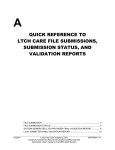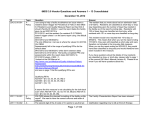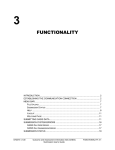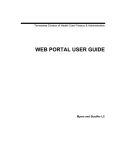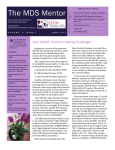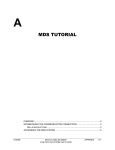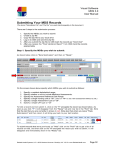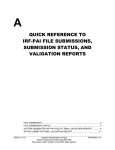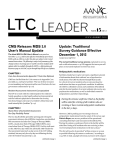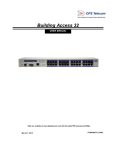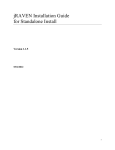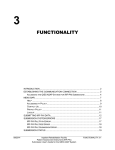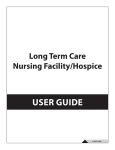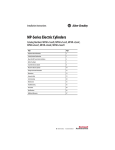Download MDS 3.0 Resident Assessment Manual Chapter 5
Transcript
CMS’s RAI Version 3.0 Manual CH 5: Submission and Correction of the MDS Assessments CHAPTER 5: SUBMISSION AND CORRECTION OF THE MDS ASSESSMENTS Nursing homes are required to submit MDS records for all residents in Medicare- or Medicaidcertified beds regardless of the pay source. Skilled nursing facilities (SNFs) and hospital swing beds are required to transmit additional MDS assessments for all Medicare beneficiaries in a Part A stay reimbursable under the SNF PPS. 5.1 Transmitting MDS Data All Medicare and/or Medicaid-certified nursing facilities or agents of those facilities and Medicare-certified swing beds must transmit required MDS data records to CMS’ QIES Assessment Submission and Processing (ASAP) system. After completion of the required assessments and/or tracking information, each provider must create electronic transmission files that meet the requirements detailed in the current MDS 3.0 Data Specifications available on the CMS MDS 3.0 web site at: http://www.cms.hhs.gov/NursingHomeQualityInits/25_NHQIMDS30.asp In addition, providers must be certain they are submitting MDS assessments under the appropriate authority. There must be a federal and/or state authority to submit MDS assessment data to the QIES ASAP system. The software used by providers should have a prompt for confirming the authority to submit each record. The provider indicates the submission authority for a record in the MDS Submission Requirement item (A0410). • • Value = 1 Value = 2 • Value = 3 Neither federal nor state required submission. State but not federal required submission (FOR NURSING HOMES ONLY). Federal required submission. See Chapter 3 for details concerning the coding of the Submission Requirement item (A0410). Providers must establish communication with the QIES ASAP system in order to submit a file. This is accomplished by using specialized communications software and hardware and the Medicare Data Communication Network (MDCN). Details about these processes will be made available in the future on the QIES Technical Support Office (QTSO) MDS 3.0 web site at: https://www.qtso.com/mds30.html Once communication is established with the QIES ASAP system, the provider can access the CMS MDS Welcome Page in the MDS system. This site allows providers to submit MDS assessment data and access various information sources such as Bulletins and Questions and Answers. The Minimum Data Set (MDS) 3.0 Provider User’s Guide provides more detailed September 2010 Page 5-1 CMS’s RAI Version 3.0 Manual CH 5: Submission and Correction of the MDS Assessments information about the MDS system. It will be made available in the future on the QTSO MDS 3.0 web site at: https://www.qtso.com/mds30.html When the transmission file is received by the QIES ASAP system, the system performs a series of validation edits to evaluate whether or not the data submitted meet the required standards. MDS records are edited to verify that clinical responses are within valid ranges and are consistent, dates are reasonable, and records are in with the proper order with regard to records that were previously accepted by the QIES ASAP system for the same resident. The provider is notified of the results of this evaluation by error and warning messages on a Final Validation Report. All error and warning messages are detailed and explained in the Minimum Data Set (MDS) 3.0 Provider User’s Guide which will be made available in the future on the QTSO MDS 3.0 web site at: https://www.qtso.com/mds30.html 5.2 Timeliness Criteria In accordance with the requirements at 42 CFR § 483.20 (f) (1), (2), and (3), long-term care facilities participating in the Medicare and Medicaid programs must meet the following conditions: • • • Completion Timing: — For all Federal/OBRA and PPS assessments, the MDS Completion Date (Z0500B) may be no later than 14 days from the Assessment Reference Date (A2300). — For the Admission assessment, the Care Area Assessment (CAA) Completion Date (V0200B2) should be no more than 14 days from the Entry Date (A1600). — For all other comprehensive MDS assessments, Annual assessment updates, Significant Change in Status assessments, and Significant Correction to Prior Comprehensive assessments, the CAA Completion Date (V0200B2) may be no later than 14 days from the Assessment Reference Date (A2300). — Entry tracking records and death-in-facility tracking records must be completed within 7 days of the Event Date (A1600 for an entry record; A2000 for a death-infacility record). State Requirements: Many states have established additional MDS requirements for Medicaid payment and quality monitoring purposes. For information on state requirements, contact your State RAI Coordinator. (See Appendix B for a list of state RAI coordinators.) Encoding Data: Within 7 days after completing a resident’s MDS assessment or tracking information, the provider should encode the MDS data. The encoding requirements are as follows: — For a comprehensive assessment (Admission, Annual, Significant Change in Status, and Significant Correction to Prior Comprehensive), encoding should be within 7 days after the CAA Care Plan Completion Date (V0200C2). September 2010 Page 5-2 CMS’s RAI Version 3.0 Manual • • CH 5: Submission and Correction of the MDS Assessments — For a quarterly or PPS assessment, encoding should be within 7 days after the MDS Completion Date (Z0500B). Submission Format: For submission, the MDS data must be in record and file formats that conform to standard record layouts and data dictionaries, and pass standardized edits defined by CMS and the State. Each MDS record must be a separate file in a required XML format. The submission file is a compressed ZIP file that may contain multiple XML files. See the MDS 3.0 Data Submission Specifications on the CMS MDS 3.0 web site for details concerning file and record formats, XML structure, and ZIP files at: http://www.cms.hhs.gov/NursingHomeQualityInits/25_NHQIMDS30.asp Transmitting Data: Submission files are transmitted to the QIES ASAP system using the Medicare Data Communication Network (MDCN). Providers must transmit all sections of the MDS 3.0 required for their State-specific instrument, including the Care Area Assessment Summary (Section V) and all tracking or correction information. Transmission requirements apply to all MDS 3.0 records used to meet both Federal and state requirements. Care plans are not required to be transmitted. — Assessment Transmission: Comprehensive assessments must be transmitted electronically within 14 days of the Care Plan Completion Date (V0200C2). All other MDS assessments must be submitted within 14 days of the MDS Completion Date (Z0500B). — Tracking Information Transmission: For entry and death-in-facility tracking records, information must be transmitted within 14 days of the Event Date (A1600 for Entry records and A2000 for death-in-facility records). Submission Time Frame for MDS Records Primary Reason (A0310A) Secondary Reason (A0310B) Entry/Discharge Reporting (A0310F) Final Completion or Event Date Submit By Admission Assessment 01 All values 10, 11, 99 V0200C2 V0200C2 + 14 Annual Assessment 03 All values 10, 11, 99 V0200C2 V0200C2 + 14 Sign. Change Assessment 04 All values 10, 11, 99 V0200C2 V0200C2 + 14 Sign. Correction Full Asmt. 05 All values 10, 11, 99 V0200C2 V0200C2 + 14 Quarterly Review Asmt. 02 All values 10, 11, 99 Z0500B Z0500B +14 Sign. Correction Prior Quarterly Asmt. 06 All values 10, 11, 99 Z0500B Z0500B + 14 PPS Assessment 99 01 through 07 10, 11, 99 Z0500B Z0500B + 14 All values All values 10 or 11 Z0500B Z0500B + 14 Death in Facility Tracking 99 99 12 A2000 A2000 + 14 Entry Tracking 99 99 1 A1600 A1600 + 14 N/A N/A N/A X1100E X1100E + 14 Type of Assessment/Tracking Discharge Correction (Modification or Inactivation) September 2010 Page 5-3 CMS’s RAI Version 3.0 Manual CH 5: Submission and Correction of the MDS Assessments Table Legend: Item Description V0200C2 Care Plan Completion Date: Date of the signature of the person completing the care planning decision on the Care Area Assessment (CAA) Summary sheet (Section V), indicating which Care Areas are addressed in the care plan. Z0500B MDS Assessment Completion Date: Date of the RN assessment coordinator’s signature, indicating that the MDS assessment is complete. A2000 Date of discharge or death A1600 Date of entry X1100E Date of the RN coordinator’s signature on the Correction Request (Section X) certifying completion of the correction request information and the corrected assessment or tracking information. • Assessment Schedule: An OBRA assessment (comprehensive or quarterly) is due every quarter unless the resident is no longer in the facility. There should be no more than 92 days between OBRA assessments. An OBRA comprehensive assessment is due every year unless the resident is no longer in the facility. There should be no more than 366 days between comprehensive assessments. PPS assessments follow their own schedule. See Chapter 6 for details. 5.3 Validation Edits The MDS system has validation edits designed to monitor the timeliness and accuracy of MDS record submissions. If transmitted MDS records do not meet the edit requirements, the system will provide error and warning messages on the provider’s validation report. Initial Submission Feedback. For each file submitted, the submitter will receive confirmation that the file was received for processing and editing by the MDS system. This confirmation information includes the file submission number, as well as the date and time the file was received for processing. Validation and Editing Process. Each time a provider accesses the MDS system and transmits an MDS file, the MDS system performs three types of validation: 1. Fatal File Errors. If the file structure is unacceptable (e.g., it is not a ZIP file), the records in the ZIP file cannot be extracted, or the file cannot be read, then the file will be rejected. The Final Validation Report will list the Fatal File Errors. Files that are rejected must be corrected and resubmitted. 2. Fatal Record Errors. If the file structure is acceptable, then each MDS record in the file is validated individually for Fatal Record Errors. These errors include: • Out of range responses (e.g., the valid codes for the item are 1, 2, 3, and 4 and the submitted value is a 6). September 2010 Page 5-4 CMS’s RAI Version 3.0 Manual • CH 5: Submission and Correction of the MDS Assessments Inconsistent relationships between items. One example is a skip pattern violation. The resident is coded as comatose (B0100 = 1) but the Brief Interview for Mental Status is conducted (C0100 = 1). Another example is an inconsistent date pattern, such as the resident’s Birth Date (Item A0900) is later than the Entry Date (Item A1600). Fatal Record Errors result in rejection of individual records by the MDS system. The provider is informed of Fatal Record Errors on the Final Validation Report. Rejected records must be corrected and resubmitted. 3. Non-Fatal Errors (Warnings). The record is also validated for Non-Fatal Errors. Non-Fatal Errors include missing or questionable data of a non-critical nature or item consistency errors of a non-critical nature. Examples are timing errors. Timing errors for a quarterly assessment include (a) the submission date is more than 14 days after the MDS assessment completion date (Z0500B) or (b) the assessment completion is more than 14 days after the assessment reference date (A2300). Another example is a record sequencing error, where an Entry record (A0310F = 01) is submitted after a quarterly assessment record (A0310A = 02) with no intervening discharge record (A0310F = 10, 11 or 12). Any Non-Fatal Errors are reported to the provider in the Final Validation Report as warnings. The provider must evaluate each warning to identify necessary corrective actions. Storage to the QIES ASAP System. If there are any Fatal Record Errors, the record will be rejected and not stored in the QIES ASAP system. If there are no Fatal Record Errors, the record is loaded into the QIES ASAP system, even if the record has Non-Fatal Errors (Warnings). Detailed information on the validation edits and the error and warning messages is available in the MDS 3.0 Data Submission Specifications on the CMS MDS 3.0 web site at: http://www.cms.hhs.gov/NursingHomeQualityInits/25_NHQIMDS30.asp and the Minimum Data Set (MDS) 3.0 Provider User’s Guide will be made available in the future on the QTSO MDS 3.0 web site at: https://www.qtso.com/mds30.html 5.4 Additional Medicare Submission Requirements that Impact Billing Under the SNF PPS As stated in CFR § 413.343 (a) and (b), providers reimbursed under the SNF PPS “are required to submit the resident assessment data described at § 483.20…. in the manner necessary to administer the payment rate methodology described in § 413.337.” This provision includes the frequency, scope, and number of assessments required in accordance with the methodology described in CFR § 413.337 (c) related to the adjustment of the Federal rates for case mix. SNFs must submit assessments according to a standard schedule. This schedule must include performance of resident assessments in specified windows near the 5th, 14th, 30th, 60th, and 90th days of the Medicare Part A stay. September 2010 Page 5-5 CMS’s RAI Version 3.0 Manual CH 5: Submission and Correction of the MDS Assessments HIPPS Codes: Health Insurance Prospective Payment System (HIPPS) codes are billing codes used when submitting Medicare Part A SNF payment claims to the Part A/Part B Medicare Administrative Contractor (A/B MAC). The HIPPS code consists of 5 positions. The first 3 positions represent the RUG-IV case mix code for the SNF resident, and the last 2 positions are an Assessment Indicator (AI) code indicating which type of assessment was completed. Standard “grouper” logic and software for RUG-IV is provided by CMS at: http://www.cms.hhs.gov/NursingHomeQualityInits/25_NHQIMDS30.asp The standard grouper uses MDS 3.0 items to determine both the RUG-IV group and the AI code. It is anticipated that facility MDS 3.0 software will incorporate the standard grouper to automatically calculate the RUG-IV group and AI code. Detailed logic for determining the RUGIV group and AI code is provided in Chapter 6. The HIPPS codes to be used for Medicare Part A SNF claims are included on the MDS. There are two different HIPPS codes. 1. The Medicare Part A HIPPS code (Item Z0100A) is normally used on the claim. The RUG version code in Item Z0100B documents which version of RUG-IV was used to determine the RUG-IV group in the Medicare Part A HIPPS code. 2. The Medicare non-therapy Part A HIPPS code (Item Z0150A) is used when the resident has been receiving rehabilitation therapy (physical therapy, occupational therapy, and/or speechlanguage pathology services) but all rehabilitation therapy ends. The RUG version code in Item Z0150B documents which version of RUG-IV was used to determine the RUG-IV group in the Medicare non-therapy Part A HIPPS code. There is also a Medicare short stay indicator (Item Z0100C) on the MDS. For a qualifying Medicare short stay, the RUG-IV grouper uses alternative rehabilitation classification logic when there has been insufficient time to establish a full rehabilitation regime. The standard grouper uses MDS 3.0 items to determine the Medicare short stay indicator. See Chapter 6 for details. Both HIPPS codes (Z0100A and Z0150A), the RUG version codes (Z0100B and Z0150B), and the Medicare short stay indicator (Z0100C) must be submitted to the QIES ASAP system on all Medicare PPS assessment records (indicated by A0310B= 01, 02, 03, 04, 05, 06, or 07). All of these values are validated by the QIES ASAP system. The Final Validation Report will indicate if any of these items is in error and the correct value for an incorrect item. Note that an error in one of these items is a non-fatal warning and the record will still be accepted in the QIES ASAP system. The Medicare Part A SNF claim cannot be submitted until the corresponding MDS Medicare PPS assessment has been accepted in the QIES ASAP system. The claim must include the correct HIPPS code for the assessment. If the HIPPS code on the assessment was in error, then the correct HIPPS code from the Final Validation report must be used on the claim. September 2010 Page 5-6 CMS’s RAI Version 3.0 Manual CH 5: Submission and Correction of the MDS Assessments 5.5 Correcting the MDS Once completed, edited, and accepted into the QIES ASAP system, providers may not “change” a previously completed MDS form as the resident’s status changes during the course of the resident’s stay. Minor changes in the resident’s status should be noted in the resident’s record (e.g., in progress notes), in accordance with standards of clinical practice and documentation. Such monitoring and documentation is a part of the provider’s responsibility to provide necessary care and services. However, it is important to remember that the electronic record submitted to and accepted into the QIES ASAP system is the legal assessment. Changes made to the electronic record after data transmission or to the paper copy maintained in the medical record are not recognized as proper corrections. Several additional processes have been put into place to assure that the MDS data are accurate both at the provider and in the QIES ASAP system: • • • • • If an error is discovered within 7 days of the completion of an MDS and before submission to the QIES ASAP system, the response may be corrected using standard editing procedures on the hard copy (cross out, enter correct response, initial and date) and correction of the MDS record in the facility’s database. The resident’s care plan should also be reviewed for any needed changes. Software used by the provider to encode the MDS must run all standard edits as defined in the data specifications released by CMS. Enhanced record rejection standards have been implemented in the QIES ASAP system. If an MDS record contains responses that are out of range, e.g., a 4 is entered when only 0-3 are allowable responses for an item, or item responses are inconsistent (e.g., a skip pattern is not observed), the record is rejected. Inaccurate data are not stored in the QIES ASAP database. If an error is discovered in a record that has been accepted by the QIES ASAP system, Modification or Inactivation procedures must be implemented by the provider to assure that the QIES ASAP system information is corrected. Clinical corrections must also be undertaken as necessary to assure that the resident is accurately assessed, the care plan is accurate, and the resident is receiving the necessary care. A Significant Change in Status assessment or a Significant Correction of a Prior assessment may be needed as well as corrections to the information in the QIES ASAP system. The remaining sections of this chapter present the decision processes necessary to identify the proper correction steps. A flow chart is provided at the end of these sections that summarizes these decisions and correction steps. September 2010 Page 5-7 CMS’s RAI Version 3.0 Manual CH 5: Submission and Correction of the MDS Assessments 5.6 Correcting Errors in MDS Records That Have Not Yet Been Accepted Into the QIES ASAP System Completion of a new MDS to reflect changes in the resident’s status is not required, unless a significant change in status has occurred. See Chapter 2 for the definition of a significant change in status. If an MDS assessment is found to have errors that incorrectly reflect the resident’s status, then that assessment must be corrected. The correction process depends upon the type of error. MDS assessments that have not yet been accepted in the QIES ASAP system include records that have been submitted and rejected, production records that were inadvertently submitted as test records, or records that have not been submitted at all. These records can generally be corrected and retransmitted without any special correction procedures, since they were never accepted by the QIES ASAP system. The paper copy should be corrected according to standard procedures detailed below. Errors Identified During the Encoding Period Facilities have up to 7 days to encode and edit an MDS assessment after the MDS has been completed. Amendments may be made to the electronic record for any item during the encoding and editing period, provided the amended response refers to the same observation period. To make revisions to the paper copy, enter the correct response, draw a line through the previous response without obliterating it, and initial and date the corrected entry. This procedure is similar to how an entry in the medical record is corrected. When the data are encoded into the provider’s MDS system from paper, the provider is responsible for verifying that all responses in the computer file match the responses on the paper form. Any discrepancies must be corrected in the computer file during the 7-day encoding period. In addition, the provider is responsible for running encoded MDS assessment data against CMS and State-specific edits that software vendors are responsible for building into MDS Version 3.0 computer systems. For each MDS item, the response must be within the required range and also be consistent with other item responses. During this 7-day encoding period that follows the completion of the MDS assessment, a provider may “correct” item responses to meet required edits. Only MDS assessments that meet all of the required edits are considered complete. For “corrected” items, the provider must use the same “period of observation” as that used for the original item completion (i.e., the same Assessment Reference Date – A2300). Any corrections must be accurately reflected in both the electronic and paper copies of the MDS (i.e., the paper version of the MDS must be corrected). Errors Identified After the Encoding Period Errors identified after the encoding and editing period must be corrected within 14 days after identifying the errors. If the record in error is an entry, discharge, or PPS assessment record (i.e., MDS Item A0310A = 99), then the record should be corrected and submitted to the QIES ASAP September 2010 Page 5-8 CMS’s RAI Version 3.0 Manual CH 5: Submission and Correction of the MDS Assessments system. The correction process can be more complex if the record in error is an OBRA assessment record (i.e., Item A0310A = 01 through 06). Major versus Minor Errors in a Nursing Home OBRA Assessment Record. OBRA assessment errors are classified as major or minor errors. Errors that inaccurately reflect the resident’s clinical status and/or result in an inappropriate plan of care are considered major errors. All other errors related to the coding of MDS items are considered minor errors. If the only errors in the OBRA assessment are minor errors, then the record should be corrected and submitted to the QIES ASAP system. The correction process is more complicated for nursing home OBRA assessments with any major errors identified after the end of the 7-day encoding and editing period but before the record has been accepted into the QIES ASAP system. First, the nursing home must correct the original OBRA assessment to reflect the resident’s actual status as of the Assessment Reference Date for that original assessment and submit the record. Second, to insure an up-to-date view of the resident’s status and an appropriate care plan, the nursing home must perform an additional, new Significant Change in Status or Significant Correction to a Prior assessment with a new observation period and Assessment Reference Date. The choice between a Significant Change or Significant Correction to a Prior assessment is based upon whether a significant change in the resident’s status has occurred. See Chapter 2 for the definition of a significant change in status. If there has been a significant change in status after the original assessment, then a new Significant Change in Status assessment is required. Otherwise a Significant Correction to a Prior assessment is required. In summary, the nursing home must take the following actions for an OBRA assessment with major errors: • • • Correct the errors in the original OBRA assessment. Submit the corrected assessment. Perform a new Significant Change in Status or a Significant Correction to a Prior assessment and update the care plan as necessary. If the assessment was performed for Medicare purposes only (A0310A = 99 and A0310B= 01 through 07), no Significant Change in Status or Significant Correction to a Prior assessment is required. Note that the Care Area Assessment (Section V) and updated care planning are not required with Medicare-only assessments. 5.7 Correcting Errors in MDS Records That Have Been Accepted Into the QIES ASAP System Errors identified in QIES ASAP system records must be corrected within 14 days after identifying the errors. Inaccuracies can occur for a variety of reasons, such as transcription errors, data entry errors, software product errors, item coding errors or other errors. The following two processes have been established to correct MDS records (assessments, entry records or discharge records) that have been accepted into the QIES ASAP system: September 2010 Page 5-9 CMS’s RAI Version 3.0 Manual • • CH 5: Submission and Correction of the MDS Assessments Modification Inactivation A Modification request moves the inaccurate record into history in the QIES ASAP system and replaces it with the corrected record as the active record. An Inactivation request also moves the inaccurate record into history in the QIES ASAP system, but does not replace it with a new record. Both the Modification and Inactivation processes require the MDS Correction Request items to be completed in Section X of the MDS 3.0. The MDS Correction Request items in Section X contain the minimum amount of information necessary to enable location of the erroneous MDS request previously submitted and accepted into the QIES ASAP system. A hard copy of the Correction Request items in Section X must be kept with the corrected paper copy of the MDS record in the clinical file to track the changes made with the modification. A hard copy of the Correction Request items (Section X) should also be kept with an inactivated record. Section X items are defined in the MDS 3.0 Data Specifications posted on the CMS web site at: http://www.cms.hhs.gov/NursingHomeQualityInits/25_NHQIMDS30.asp More detailed instructions and examples for the correction process are included in the “Provider Instructions and Examples for Making Corrections in MDS 3.0 Records”, which will be made available in the future on the CMS web site at: http://www.cms.hhs.gov/NursingHomeQualityInits/25_NHQIMDS30.asp Modification Requests A Modification Request should be used when an MDS record (assessment, entry record or discharge record) is in the QIES ASAP system, but the information in the record contains clinical or demographic errors. The Modification Request can modify any MDS items with the exception of Type of Provider (Item A0200), Submission Requirement (Item A0410), and the control item containing the Stateassigned facility submission ID (FAC_ID). Correction of these items requires a Special Manual Record Correction Request (discussed later in this chapter). MDS 2.0 versus MDS 3.0. The MDS 2.0 correction process also restricted modification of key resident ID items (name, birthdate, gender, and social security number), reason for assessment items, and event dates (assessment reference date, entry date and discharge date). With the MDS 2.0, correction of these items required an Inactivation followed by submission of a new correct record. In contrast, the MDS 3.0 allows correction of all of these items with a single Modification record. The only MDS 3.0 items that cannot be corrected with a Modification Request are those listed in the preceding paragraph. When an error is discovered in an MDS 3.0 entry, discharge or PPS assessment record that is not an OBRA assessment (where Item A0310A = 99), the provider must take the following actions to correct the record: September 2010 Page 5-10 CMS’s RAI Version 3.0 Manual CH 5: Submission and Correction of the MDS Assessments 1. Create a corrected record with all items included, not just the items in error. 2. Complete the required Correction Request Section X items and include with the corrected record. Item X0100 should have a value of 2, indicating a modification request. 3. Submit this modification request record. If errors are discovered in a nursing home OBRA assessment (Item A0310A = 01 through 06) in the QIES ASAP system, then the nursing home must determine if there are any major errors. If the only errors are minor errors, the nursing home must take the following actions to correct the OBRA assessment: 1. Create a corrected record with all items included, not just the items in error. 2. Complete the required Correction Request Section X items and include with the corrected record. Item X0100 should have a value of 2, indicating a modification request. 3. Submit this modification request record. When any major error is discovered in an OBRA assessment in the QIES ASAP system, the nursing home must take the following actions to correct the OBRA assessment: Create a corrected record with all items included, not just the items in error. 4. Complete the required Correction Request Section X items and include with the corrected record. Item X0100 should have a value of 2, indicating a modification request. 5. Submit this modification request record. 6. Perform a new Significant Correction of a Prior assessment or Significant Change in Status assessment and update the care plan as necessary. The choice between a Significant Change or Significant Correction of a Prior assessment is based upon whether a significant change in the resident’s status has occurred. See Chapter 2 for the definition of a significant change in status. If there has been a significant change in status after the original assessment, then a new Significant Change in Status assessment is required. Otherwise a Significant Correction of a Prior assessment is required. When errors in an OBRA assessment in the QIES ASAP system have been corrected in a more current OBRA assessment, the nursing home is not required to perform a new Significant Change or Significant Correction of a Prior assessment. In this situation, the nursing home has already updated the resident’s status and care plan. However, the nursing home must use the Modification process to assure that the erroneous assessment residing in the QIES ASAP system is corrected. Inactivation Requests An Inactivation should be used when a record has been accepted into the QIES ASAP system but the corresponding event did not occur. For example, a discharge record was submitted for a resident but there was no actual discharge. When inactivating a record, the provider is required to submit an electronic Inactivation Request record. This record is an MDS record but only the Section X items are completed. This is September 2010 Page 5-11 CMS’s RAI Version 3.0 Manual CH 5: Submission and Correction of the MDS Assessments sufficient information to locate the record in the QIES ASAP system, inactivate the record and document the reason for inactivation. 5.8 Special Manual Record Correction Request A few types of errors in a record in the QIES ASAP system cannot be corrected with an automated Modification or Inactivation request. These errors are: 1. The record is a test record inadvertently submitted as production. 2. The record has the wrong submission requirement in item A0410. 3. The record has the wrong facility ID in the control item FAC_ID. In all of these cases, the facility must submit a written request to the state MDS Coordinator to have the problems fixed. When a test record is in the QIES ASAP system, the problem must be manually evaluated in the QIES ASAP system and the QIES ASAP system appropriately corrected. A normal Inactivation request will not totally fix the problem, since it will leave the test record in a history file and may also leave information about a fictitious resident. Manual correction is necessary to completely remove the test record and associated information. A QIES ASAP system record with an incorrect submission requirement in item A0410 is a very serious problem. Submission of MDS assessment records to the QIES ASAP system constitutes a release of private information and must conform to privacy laws. Item A0410 is intended to allow appropriate privacy safeguards, controlling who can access the record and whether the record can even be accepted into the QIES ASAP system. A normal Modification or Inactivation request cannot be used to correct the A0410 value, since a copy of the record in error will remain in the QIES ASAP system history file with the wrong access control. Consider a record in the QIES ASAP system with an A0410 value of 3 (federal submission requirement) but there was actually no state or federal requirement for the record (A0410 should have been 1). The record should not be in the QIES ASAP system at all and manual correction is necessary to completely remove the record from the QIES ASAP system Consider a record with an A0410 value of 3 (federal submission requirement) but the record is only required by the state (A0410 should have been 2). In this case there is both federal and state access to the record, but access should be limited to the state. Manual correction is necessary to correct A0410 and reset access control, without leaving a copy of the record with the wrong access in the QIES ASAP system history file. If a QIES ASAP system record has the wrong main facility ID (control item FAC_ID), then the record must be removed without leaving any trace in the QIES ASAP system. The record also should be resubmitted with the correct FAC_ID value. An Example MDS 3.0 Manual Correction Request Worksheet appears on the next page. Such a worksheet can be used to submit the necessary information to the state MDS Coordinator. September 2010 Page 5-12 CMS’s RAI Version 3.0 Manual CH 5: Submission and Correction of the MDS Assessments Example MDS 3.0 Manual Correction Request Worksheet The provider must submit the following information to the state MDS Coordinator in writing: Select reason for record correction: Test Record Delete A0410 Change Wrong FAC-ID Delete Facility information Name ID (FAC_ID) Requester information Name Title Phone # Resident information First Name Last Name SSN Birthdate Gender Record information A0310A A0310B A0310C A0310D A0310F Target Date1 Assessment Internal ID (if available)2 Submission information Date and time Batch # A0410 (Submission Requirement) values (only if changing A0410) Submitted (incorrect) Corrected 1 Target date is: MDS Item A2300 (reference date) for an assessment record. MDS Item A2000 (discharge date) for a discharge record. MDS Item A 1600 (entry date) for an entry record. 2 The Assessment Internal ID is present on the Final Validation Report for the record. September 2010 Page 5-13 Correction Policy Flowchart CMS’s RAI Version 3.0 Manual September 2010 Page 5-14 Manual deletion request is required if test record submitted as production record, if record contains incorrect FAC_ID, or if record was submitted with an incorrect submission requirement value (A0410), for example send in as federally required (A0410 = 3) but should have been state required (A0410 = 2). Otherwise, automated inactivation or modification required: (a) if event did not occur (see note #3, below), submit automated inactivation, (b) if event occurred, submit automated modification. 2 Record has not been data entered, has not been submitted, or has been submitted and rejected by ASAP. 3 The event occurred if the record reflects an actual entry or discharge or if an assessment was actually performed for the resident. If a record was created in error (e.g., a discharge was created for a resident who was not actually discharged), then the event did not occur. 4 OBRA assessments. are comprehensive assessments with A0310A=01,03,04,05, or quarterly assessments with A0310B=02,06. 3 The assessment contains a major error which has not been corrected by a subsequent assessment. 6 Final completion date is Item V0200C2 for a comprehensive and Z0500B for all other assessments. CH 5: Submission and Correction of the MDS Assessments 1














